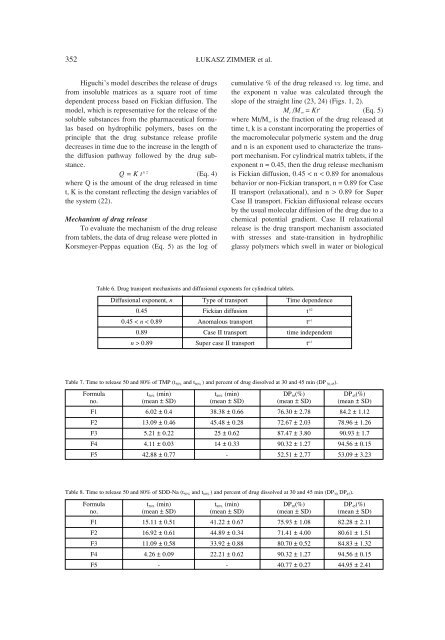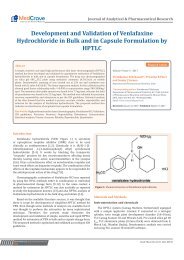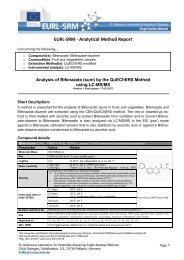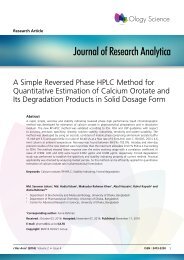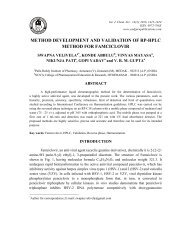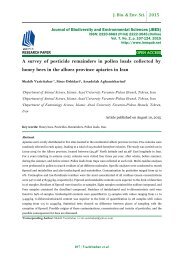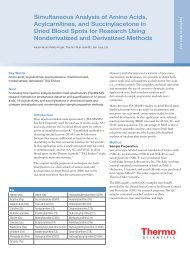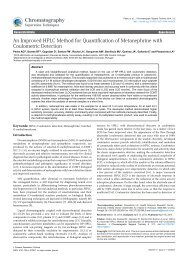acta 2_2015
acta 2_2015
acta 2_2015
- No tags were found...
You also want an ePaper? Increase the reach of your titles
YUMPU automatically turns print PDFs into web optimized ePapers that Google loves.
352 £UKASZ ZIMMER et al.Higuchiís model describes the release of drugsfrom insoluble matrices as a square root of timedependent process based on Fickian diffusion. Themodel, which is representative for the release of thesoluble substances from the pharmaceutical formulasbased on hydrophilic polymers, bases on theprinciple that the drug substance release profiledecreases in time due to the increase in the length ofthe diffusion pathway followed by the drug substance.Q = K t 1/ 2 (Eq. 4)where Q is the amount of the drug released in timet, K is the constant reflecting the design variables ofthe system (22).Mechanism of drug releaseTo evaluate the mechanism of the drug releasefrom tablets, the data of drug release were plotted inKorsmeyer-Peppas equation (Eq. 5) as the log ofcumulative % of the drug released vs. log time, andthe exponent n value was calculated through theslope of the straight line (23, 24) (Figs. 1, 2).M t /M ∞ = Kt n (Eq. 5)where Mt/M ∞ is the fraction of the drug released attime t, k is a constant incorporating the properties ofthe macromolecular polymeric system and the drugand n is an exponent used to characterize the transportmechanism. For cylindrical matrix tablets, if theexponent n = 0.45, then the drug release mechanismis Fickian diffusion, 0.45 < n < 0.89 for anomalousbehavior or non-Fickian transport, n = 0.89 for CaseII transport (relaxational), and n > 0.89 for SuperCase II transport. Fickian diffusional release occursby the usual molecular diffusion of the drug due to achemical potential gradient. Case II relaxationalrelease is the drug transport mechanism associatedwith stresses and state-transition in hydrophilicglassy polymers which swell in water or biologicalTable 6. Drug transport mechanisms and diffusional exponents for cylindrical tablets.Diffusional exponent, n Type of transport Time dependence0.45 Fickian diffusion t 1/20.45 < n < 0.89 Anomalous transport t n-10.89 Case II transport time independentn > 0.89 Super case II transport t n-1Table 7. Time to release 50 and 80% of TMP (t 50% and t 80% ) and percent of drug dissolved at 30 and 45 min (DP 30,45 ).Formula t 50% (min) t 80% (min) DP 30 (%) DP 45 (%)no. (mean ± SD) (mean ± SD) (mean ± SD) (mean ± SD)F1 6.02 ± 0.4 38.38 ± 0.66 76.30 ± 2.78 84.2 ± 1.12F2 13.09 ± 0.46 45.48 ± 0.28 72.67 ± 2.03 78.96 ± 1.26F3 5.21 ± 0.22 25 ± 0.62 87.47 ± 3.80 90.93 ± 1.7F4 4.11 ± 0.03 14 ± 0.33 90.32 ± 1.27 94.56 ± 0.15F5 42.88 ± 0.77 - 52.51 ± 2.77 53.09 ± 3.23Table 8. Time to release 50 and 80% of SDD-Na (t 50% and t 80% ) and percent of drug dissolved at 30 and 45 min (DP 30, DP 45 ).Formula t 50% (min) t 80% (min) DP 30 (%) DP 45 (%)no. (mean ± SD) (mean ± SD) (mean ± SD) (mean ± SD)F1 15.11 ± 0.51 41.22 ± 0.67 75.93 ± 1.08 82.28 ± 2.11F2 16.92 ± 0.61 44.89 ± 0.34 71.41 ± 4.00 80.61 ± 1.51F3 11.09 ± 0.58 33.92 ± 0.88 80.70 ± 0.52 84.83 ± 1.32F4 4.26 ± 0.09 22.21 ± 0.62 90.32 ± 1.27 94.56 ± 0.15F5 - - 40.77 ± 0.27 44.95 ± 2.41


